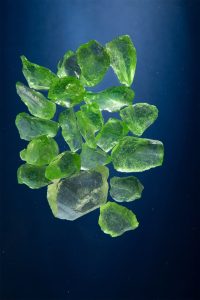Green polyphosphate stone
Green polyphosphate stone
Product code ST-11
General specifications
Green polyphosphate crystals have the following properties: 1. Gradual removal and containment of existing sediments and preventing the formation of new sediments in hot water lines by surrounding calcium and magnesium ions dissolved in water. 2. Contains effective compounds to reduce corrosion and create a protective layer in water lines. 3. Making the passing water clear by separating minerals and controlling sediments. 4. Continuous and stable water purification with slow dissolution of polyphosphate stones. 5. Reducing maintenance costs of related systems and facilities and reducing energy consumption. 6. It has the highest efficiency for water with hardness lower than 500ppm and water temperature up to 85°C. Physical and chemical properties 1. Appearance characteristics of transparent green crystal 2. Solubility in water (@25 ˚C) slightly soluble 3. pH (@25 ˚C) 6.5-7 4. Purity (%) 95.4 5. P2O5 (%) 63.5
Indications *
Household water systems such as packages and water heaters, washing machines, dishwashers, etc. * Industrial cooling towers, refrigeration equipment, air conditioning equipment * In pools and water sources of water storage Method of Use 1. Polyphosphate stones are generally placed in 5 inch, 7 inch or 10 inch cartridges. The amount of polyphosphate used depends on the flow of water passing through it.
A 5-inch cartridge is recommended for home use. 2. It is enough to put polyphosphate filters in the inlet water
path of the desired device (package, washing machine, etc.). 3. To use polyphosphate crystals as sediment trap in the system, The pH of the incoming water should be between 6-8 and the temperature of the
incoming water should be less than 45 °C.
4.
After some time (according to the amount of water consumed and the temperature of the
incoming water), these crystals will run out in the cartridges and must be recharged. Safety and maintenance 1. The optimum storage temperature for polyphosphate stones is
5-30°C and should be kept in a dry and cool place
2. Avoid exposing polyphosphate filters to direct sunlight,
because in this case, the possibility of algae growth increases.
t
them from freezing because the freezing of the filters will cause small cracks
and break them, which may cause water leakage.
What is polyphosphate and how does it purify water?
One of the major problems of city water that causes deposits in household
appliances and their failure is the high hardness of the water and so-called chalk in the water.
Sediment is the accumulation of mineral substances that enter homes
and institutions through tap water. When water is heated or some of it evaporates,
layers of sediment are formed on the walls of pipes, tanks and faucets.
The white scale that forms in the opening of faucets, washing machines, dishwashers, etc.,
indicates the deposition of calcium and magnesium carbonate.
How does polyphosphate purify water?
Dissolving a small amount of polyphosphate in water prevents the formation of insoluble carbonates
and thus prevents the formation of sediment in the system. Phosphates are considered to be one of the
factors to counteract and inhibit iron ions and water hardness. In addition,
these materials inhibit the corrosion of metals by forming a thin neutral layer on metal
surfaces and acting as a covering.
Therefore, polyphosphates do not reduce water hardness, but prevent
the formation of calcium and magnesium deposits.
Polyphosphate crystals are placed in chambers along the water flow path.
As the water passes through the filter, the polyphosphate
crystals gradually dissolve and enter the water.
In fact, with this action, polyphosphates surround and surround the dissolved calcium
and magnesium ions and reduce their tendency to settle and form calcite sediment
(hard sediment like kettle bottom) and aragonite sediment (soft sediment). give
In fact, there is sediment and plaster in the water and it does not disappear,
but these sediments and plaster do not have a tendency to stick to the wall and walls,
and if sediment is formed, the sediments will be softer like mud.
Disadvantages of polyphosphate filters
The disadvantage of this method is that phosphates are the favorite food of bacteria,
so another problem arises and that is the growth of bacteria (the problem is not acute and may occur
in certain circumstances). For example
(it contains some phosphate), but it is not a problem to contact the skin.
(some manufacturing companies claim that it is not a problem for
food consumption and that they are food grade)
What is the useful life of polyphosphate filters?
As the phosphate crystals dissolve in the water, after some time the tank is
emptied and the remaining crystals become a paste. In this case, buy a small amount
of phosphate from water purification or package and radiator stores and fill the filter chamber again.
Household filters have a useful life of 6 months to 1 year.




